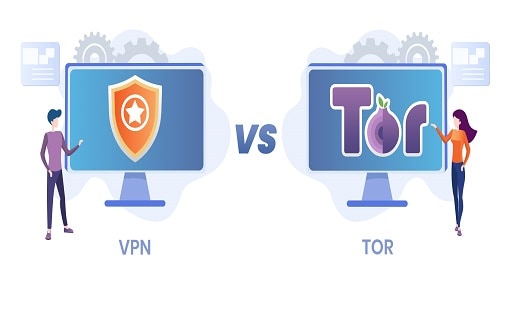Different between Tor and Decentralized VPNs: Despite the fact that the internet is meant to be about freedom, it is continually monitored by governmental agencies, internet service providers, and hostile organizations.
It is impossible to browse the internet in privacy at any time, but users can safeguard the data they communicate online by using technologies such as decentralized virtual private networks (VPNs) and Tor. So, if you had a choice between using a VPN or Tor, which would you go with?

Why is it Important to Remain Anonymous Online?
It is necessary to have a solid understanding of why maintaining anonymity when online is so critical before diving into decentralized VPNs like Tor.
When you search a website on the internet, the device you use will make queries to the Internet Service Provider (ISP) that you use (ISP). As soon as the request is received, your Internet service provider is aware of both your IP address and the address of the website you are trying to access. Your Internet service provider will be able to determine your location and other information about the website you are seeing as a result of this.
Your request, along with your IP address, is forwarded by your Internet service provider to the website you are trying to access. Your Internet service provider (ISP) as well as the website you are currently viewing are aware of the areas you have been surfing.
However, if you are a returning client on a certain website, the staff there will be familiar with your browsing patterns and may recommend items to you based on the websites you have visited in the past. The website will have a decent notion of what you like thanks to the use of third-party cookies and other tactics that include fingerprinting your device. This will allow them to serve you adverts that are more relevant to you. They also have the option of blocking content.
There are technologies available, such as Tor and DVPNs, that can help us tackle this problem. They do this by intercepting traffic as it goes from the user’s Internet service provider (ISP) to the website in question, which prevents the website from discovering the location from which the user is browsing based on the IP address.
What is Tor
Tor is a software program that was developed by the United States Naval Research Laboratory to assist users in connecting to the internet anonymously and without being monitored. This is how the process goes.
Therefore, when you search a website, your browser will submit a request to your Internet service provider (ISP), who will then link you to the website. Users of Tor do not connect directly to the website itself when using the service. They connect instead to the Tor network, which provides anonymity through the use of onion routing. To accomplish this, the user will not use their standard web browser; rather, they will utilize Tor, which is software that facilitates user connections to the Tor network.
Here is how data are transmitted via Tor.
Sending data to the ISP: All user requests are routed to your internet service provider, just as they would be if you were accessing the internet without Tor. That stated, when users are using the Tor network, traffic is not routed directly from the client to the website. Instead, information is delivered to the Tor network’s entrance node for processing. Due to this, the ISP does not have any knowledge regarding the eventual destination of the client’s request. All it knows is that the data is being transferred from the client to a Tor entry node.
Transmitting information inside Tor: To offer an extra degree of anonymity, client requests are not relayed from the entry node to the destination website. Instead, the data is routed to another node inside the Tor network called a middle relay. This relay further transmits the data to the exit relay, which eventually sends the data to the website.
Sending data to the website: On reaching the exit node, Tor transfers the data to the website the client sought. After the Tor network has received the client’s response, it will then send data back to the client in the same way.
When a user tries to connect to a website by using Tor, the ISP is unaware of the client’s ultimate destination because Tor conceals this information. In the same vein, the website does not contain any information regarding the customer. Therefore, people who wish to remain anonymous on the internet can do so by utilizing Tor.
In addition to this, the multiple layers of encryption utilized by Tor make it impossible for eavesdroppers to view the data that is being transferred using the network. Because each of these layers of encryption is removed sequentially at the entry, middle, and exit relays, onion routing got its name from this process, which is analogous to peeling the layers of an onion.
Disadvantages of using the Tor Network?
The usage of Tor, even though it offers users anonymity and security, does come with a few limitations.
Content blocking: When visitors browse websites using Tor, the proprietors of such websites do not receive user information, such as their IP addresses or data from third-party cookies. As a result, many websites restrict traffic from Tor.
Speed: When you use Tor, your internet connection will be slower because the network will route all of your requests through three distinct nodes before delivering them to their final destination. In point of fact, according to a comparison that was carried out by ScienceDirect between typical internet traffic and that carried by the Tor network, the performance differential can be up to one hundred times slower when using the Tor network.
Potential vulnerabilities: Even though Tor has multiple layers of encryption and employs three separate nodes for bouncing traffic, the entry and exit nodes can still be compromised, which will result in sensitive user information and location being revealed.
What are decentralized VPNs?
It is essential to have a solid foundational knowledge of virtual private networks (VPNs) and their operation before moving on to decentralized VPNs (DVPNs). A virtual private network, or VPN, is short for virtual private network, and it refers to a network of servers that collects your internet traffic, encrypts it, and then sends it to a website without compromising your privacy. Having said that, the issue with virtual private networks (VPNs) is that they are owned by private companies. This means that when you use a VPN, you are trusting a third party to route all of your internet data.
When you utilize a virtual private network, your data security is at risk from not one but two sources: your Internet service provider and the VPN provider. Decentralized virtual private networks (VPNs) are a technology that was developed as a solution to this problem. This technology makes use of blockchain technology to alleviate the issues that traditional VPNs have.
A virtual private network (VPN) provider that is not controlled by a single centralized organization is said to as decentralized. On the other hand, peers on the internet are the ones to give the services for a DVPN.
Your data does not leave a server farm controlled by a VPN service provider when you use a DVPN to connect to the internet. Instead, the traffic you send and receive is directed through public devices that are connected to the DVPN network using a decentralized application. These devices are a collection of computers that are connected to the decentralized network. In exchange for a cryptographic token that is produced by the network, these computers offer up a portion of the internet bandwidth that they have available to them. When compared to Tor, decentralized virtual private networks (VPNs) typically provide users with faster browsing speeds. This is because of the incentive structure of VPNs.
A distributed private virtual network, or DVPN, is a network of computers connected that, similar to Tor, collects your internet traffic and sends it to a website without revealing any of your personal information in the process. In contrast to Tor, a decentralized private virtual network (DVPN) builds its networks not using onion routing but with distributed ledger technology (Blockchain).
On a DVPN, there is no requirement for a centralized company for all of the nodes to get compensation for the services they render. The nodes that make up a DVPN are not allowed to run in a voluntary capacity and are instead compensated for the amount of network bandwidth they make available.
In addition to this, users of Tor have no control over the exit node from which the traffic will flow to the website. As a result, Tor is frequently unable to be used to access country-specific content; yet, it can circumvent content prohibitions imposed by government agencies. Users of DVPNs, on the other hand, can select the nation in which they want the traffic to originate, which enables them to access content that is only available in certain countries on streaming services.
Tor and Decentralized VPNs: A Side-by-Side Comparison Now that we have a grasp of how both Tor and decentralized VPNs operate, we can compare and contrast the two systems.
Tor or a DVPN: Which is better
Tor is the best option to pursue if you want to surf the internet in complete secrecy and anonymity. In addition to providing many layers of data encryption, it also offers a high degree of anonymity on the internet because of the three-hop onion routing that it uses.
Therefore, if you want to access regionally restricted websites or unblock streaming video without sacrificing a significant portion of your network speed or putting your faith in a VPN service provider, your best chance is to use a decentralized virtual private network (VPN).
Would you like to read more about the difference between Tor and Decentralized VPNs-related articles? If so, we invite you to take a look at our other tech topics before you leave!









